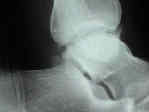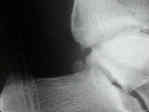- Discussion:
- two processes, lateral & posterior, project from body of talus
- either process may be fractured, either as isolated injury or assoc w/ other ankle or talar injuries;
- diff dx of posterior ankle pain: (os trigonum)
- embryology:
- posterior process arises from secondary ossification center that fuses w/ talar body at about age 12;
- os trigonum is relatively frequently seen accessory bone of foot found just posterior to lateral tubercle of posterior process;
- it may be considered a non united portion of the lateral tubercle;
- anatomy of posterior process:
- comprised of 2 tubercles: medial & lateral;
- undersurface of tubercles comprise posterior 25% of posterior facet of the subtalar joint;
- FHL runs between these tubercles, and can be have synovitis in this area (ballet dancers);
- lateral tubercle serves as attachment of posterior talo-fibular ligament;
- lateral tubercle has an articular surface, & frx thru this tubercle is often associated w/ arthrosis;
- medial tubercle:
- serves as attachment for posterior 1/3 of deltoid ligament;
- serves as the medial limb of the bifurcate talocalcaneal ligament inferiorly;
- Frx of Lateral Tubercle of Posterior Process (Sheppard's Frx):
- inversion of ankle may avulse tubercle leaving PTFL intact;
- frx may also occur when ankle is forced into extreme equinus;
- clinical findings:
- patients will present with ankle sprain symptoms:
- posterolateral ankle tenderness may be elicited;
- decreased & painful motion of ankle and subtalar joints;
- active flexion of great toe may also produce pain as FHL moves over fracture site (between medial & lateral tubercles;)
- lateral tubercle has an articular surface, & frx thru this tubercle is often associatted w/ arthrosis;
- Frx of Medial Tubercle:
- look for tenderness and perhaps a mass just posterior to medial malleolus and pain w/ motion of great toe (due to motion of FHL);
- treatment may involve excision of the the fragment;

- Radiographs:
- lateral x-ray:
- postero-lateral tubercle is seen in profile;
- os trigonum may be seen just posterior to lateral tubercle of posterior process (bilateral in 60%);
- MRI:
- look for marrow edema in the talus
- w/ fluid surrounding the Os and associated marrow edema (absence of talar marrow edema), then consider os trigonum as the cause of pain;

- Treatment:
- minimally displaced fractures are treated w/ short leg cast for 4 to 6 weeks;
- some suggest casting in 15 deg of plantar flexion;
- Complications:
- nonunions are uncommon:
- pt will note persistent pain, esp w/ extreme plantar flexion & limitation of subtalar motion;
- surgical excision of the ununited fragment thru a posterolateral ankle arthrotomy may relieve the pain
Excision of ununited fractures of the posterior process of the talus: a treatment for chronic posterior ankle pain.
Avulsion fractures of the medial tubercle of the posterior process of the talus.
Diagnosis of medial tubercle fractures of the talar posterior process using oblique views.
Use of a 30-Degree External Rotation View for Posteromedial Tubercle Fractures of the Talus.
Treatment of posterior ankle pain by excision of a bipartite talar fragment

